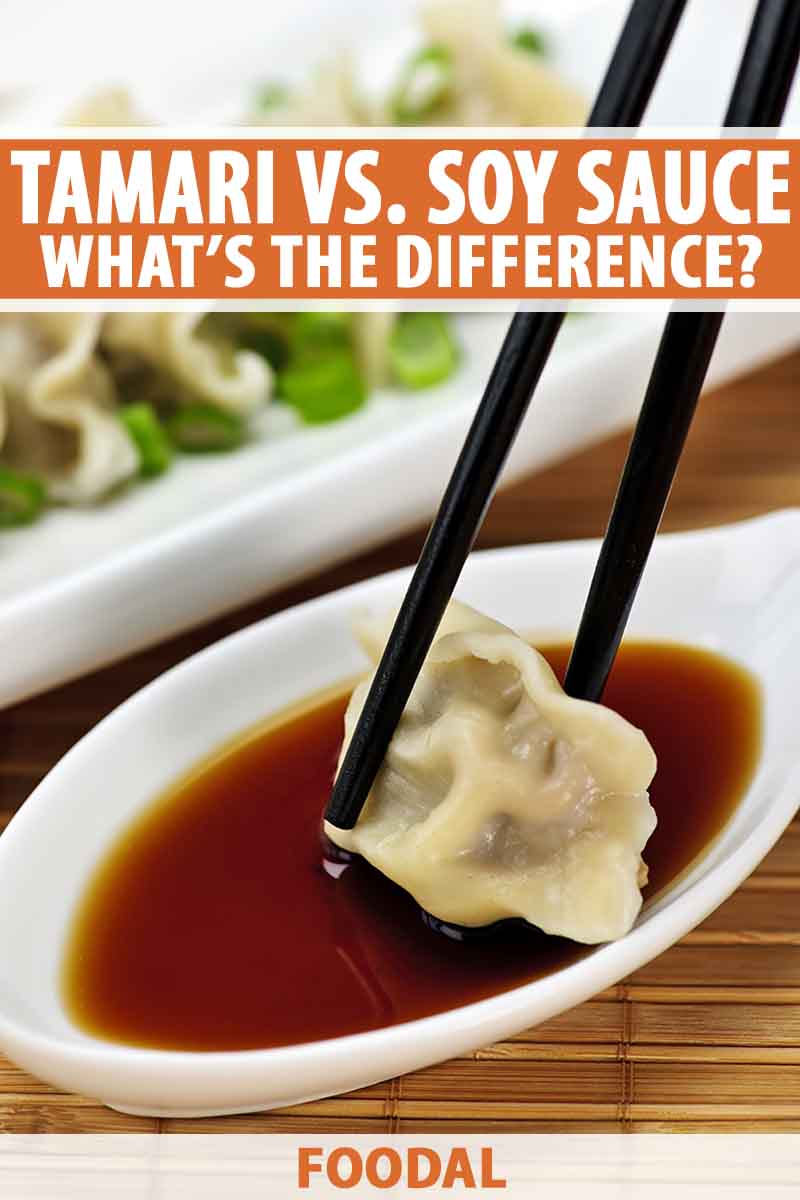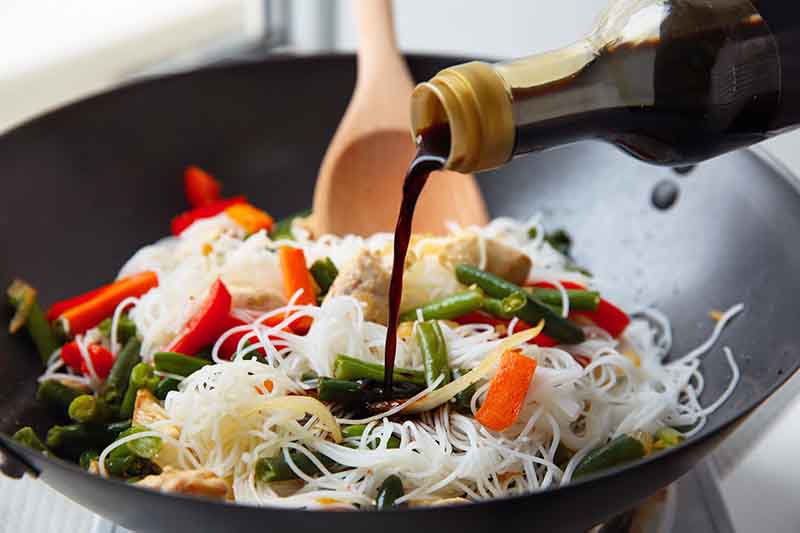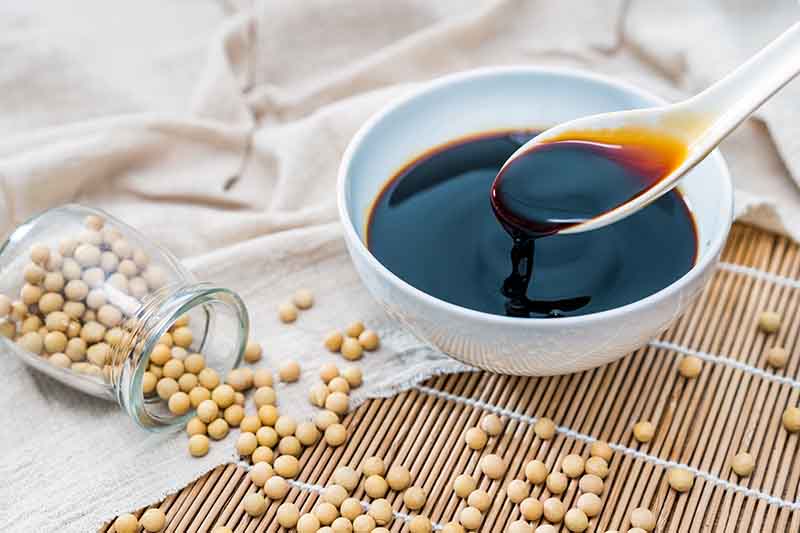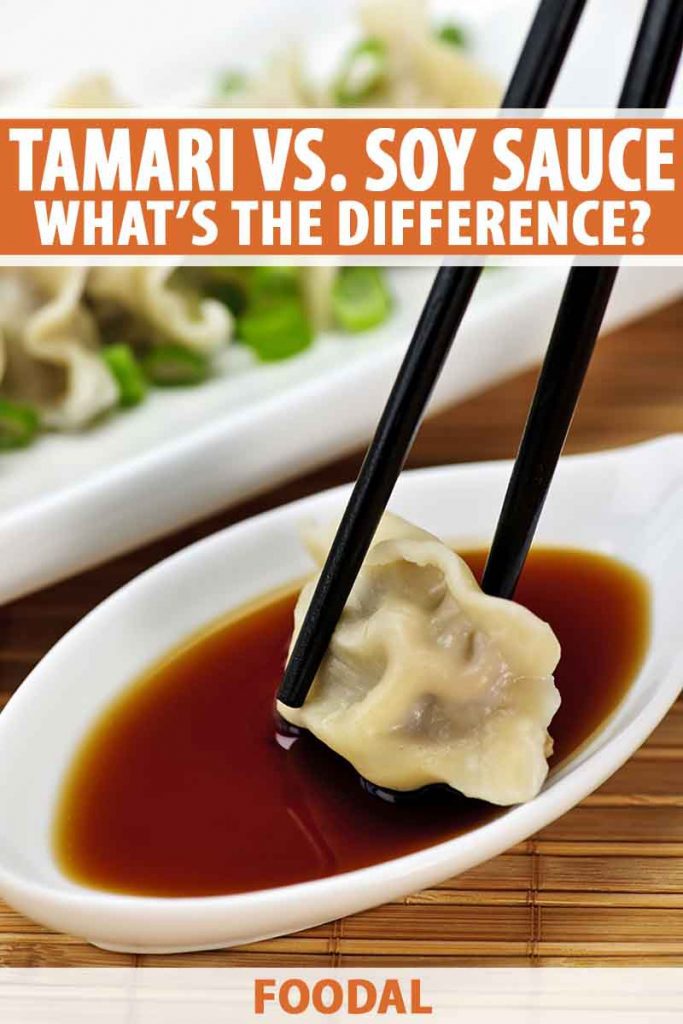I enjoy ordering takeout from a local restaurant that serves both Chinese and Japanese foods, ranging from egg foo young and hot and sour soup to sushi and soba noodles.

And being a gluten-free diner, I always ask for a packet of gluten-free soy sauce with my order.
Little did I know that what I was getting was really a different condiment altogether.
Read on and I’ll explain, as we explore the origins, similarities, and differences between two related fermented condiments with deep roots in Asia: tamari and soy sauce.
Here’s the lineup:
What’s the Difference Between Tamari and Soy Sauce?
Soy Sauce Then and Now
In ancient China, liquor was fermented with Aspergillus mold, or “koji.” This same fermentation process was also used to make fish and meat pastes called “jiang.”

The process acted as a preservative, enabling the average person to make and store protein sources for use during lean times.
Gradually, soybeans began to replace fish and meat, as they were also protein sources that were more readily available, and cheaper.
While making the classic bean paste, the liquid was traditionally pressed out and discarded – until someone discovered that it tasted delicious, that is.
When the beans were fermented, the protein they contained broke down and released healthy amino acids, rich in what the Japanese would later call “umami,” a savory and meaty/earthy flavor.
The tasty residue became known as “jiàngyóu,” and this was the earliest form of what we recognize today as soy sauce.
By about the sixth century, brews like jiàngyóu became coveted condiments offered to VIP guests at imperial feasts.

It is believed that a student of Buddhism who was visiting China from Japan observed the process, and brought the newfound knowledge back to his homeland.
In addition to an open-armed welcome to Buddhism, “miso” or bean paste, and “tamari,” the exuded liquid, were widely embraced in Japan thereafter.
Gradually, the addition of wheat made production faster and even more cost-effective. However, the quality declined. As the bean content was decreased, the result was a less nuanced, paler, saltier, thinner liquid.
Tamari remained closer to its roots, made with mostly beans and little to no wheat, to create a condiment with more depth of flavor, slightly less salt, a darker color, and a thicker consistency. It is generally labeled as “tamari soy sauce” today.
In the 1700s, commercial manufacturing and exporting were underway in Japan. By the early 1900s, the salty liquid was being bottled in the United States.
Fast-forward to today and there are numerous varieties that range from dark to light, thick to thin, pungent to sweet, and salty to low-sodium. They are readily available to everyone from home cooks to gourmet chefs in the finest kitchens.
Sauce Sense
The traditional brewing process requires two stages of fermentation, and the addition of “starters,” – like aspergillus mold, yeast, and lactobacillus bacteria – at the appropriate times to elicit layer upon layer of rich umami flavor.

Natural brewing produces the best tasting products, and the longer they age, the more flavorful they are. Most are ready in about six months, but some may be five years in the making. Expect prices commensurate with the labor involved.
There are also cheaper items that are chemically processed and aged for far shorter periods. These tend to have a bitter, rather than more savory, taste.
At this point, you’re likely wondering, “Just how salty are these fermented condiments?”
They’re very salty!
Expect sodium levels to range from approximately 500 to 1,000 milligrams of sodium per tablespoon. And even though tamari tends to be lower in salt, this is not always the case, especially with the low-sodium products that are available.
If you are looking for a gluten-free condiment, be sure to read labels closely. Only a tamari product has the potential to be gluten-free, as it is made with little to no wheat.
It is important to note that brewed soy products also contain up to two percent alcohol. It is a natural byproduct of the fermentation process, in which sugars are broken down and potentially beneficial, flavorful amino acids as well as alcohol are released.
When added to foods as they are cooking, the alcohol burns off. However, straight out of the bottle, it remains. Because of this, as well as the high sodium content, parents may want to use caution when preparing food for children with these condiments.
Lastly, as is typical of fermented foods, our subject condiments contain histamine, and may cause adverse immune responses and/or GI reactions in those with histamine intolerances.
There are non-fermented alternatives available that offer similar umami flavor, but with less salt. Liquid aminos are made from hydrolyzed soybeans, and coconut aminos are derived from coconut blossom nectar. Both are labeled as naturally gluten- and alcohol-free.
Substitution Guidelines
Often referred to simply as “soy” in recipes, it may be difficult to decide what type to use.

You can substitute tamari and regular sauce tablespoon for tablespoon, or in a 1:1 ratio.
However, it is important to know how they perform in recipes.
If tamari is called for, it is likely because the goal is to achieve a slightly thicker consistency with discernable layers of flavor and salty undertones. An example of its best use is as a stand-alone for dipping foods like fried dumplings, shrimp, and sushi.
If soy sauce is the recommended ingredient, you are likely incorporating it into a recipe like a marinade, soup, or stir-fry that requires a thin liquid salt substitute that turns a dish pleasingly brown.
Using a regular brewed brand for dipping results in a thinner product with a salty punch that may overpower your food.

Conversely, adding tamari to prepared dishes may contribute some unwanted thickness and deprive dishes of needed salt.
Note the different ingredients required in our recipes for flavorful sauteed mushrooms that call for tamari, Korean beef tacos made with soy sauce or liquid aminos, and quick and easy Kung Pao chicken that calls for a low-sodium soy sauce.
For the Korean beef tacos, you may want to try a Korean brand, and select either the standard, light-colored, salty “soup” soy sauce, guk-ganjang, or the more aged, sweeter, less salty ganjang variety. Beware of exceptionally high sodium levels and additives.
Or, perhaps you’d like to splash on a classic Vietnamese “tuong,” to add a subtle sour note before taking that first delicious bite.

Stock your pantry with tamari and regular brewed condiments for cooking, dipping, and splashing on prepared dishes like noodles, rice, salads, and soups.
Open bottles generally keep for up to one year without refrigeration. Discard unused portions if they have an “off” odor or altered appearance.
Unopened bottles should stay fresh on the shelf for three years.
As for packets from your favorite takeout restaurant, expect them to stay fresh and flavorful for up to two years.
You may also enjoy condiments that contain soy sauce, like teriyaki and tempura sauces. Note that open bottles of these products require refrigeration, and last approximately one or two years, respectively.
Unopened bottles of these blends remain fresh at room temperature in a dark cabinet for three years.
Boost the Umami
In ancient China, when salt reserves were the battlegrounds of war, discovering that the salty residue of protein paste production was not only edible, but a savory feast for the palate, was a profitable revelation.

Today’s variety of products give home cooks options for making substitutions.
Let’s recap:
For a rich stand-alone attraction, choose tamari for a slightly thicker condiment with layers of flavor and salty undertones.
Incorporate regular soy sauce into prepared dishes that call for its saltiness, pungent punch, and thin consistency.
Seek out low-sodium and gluten-free products as needed.
And finally, keep bottles handy to enhance your favorite hot and cold dishes with a generous splash as desired.
What recipes are on your agenda today? Will you use either of these fermented condiments in your cooking? Please share your suggestions in the comments section below.
If you found this guide to understanding basic cooking ingredients useful, we recommend reading the following next:
- Grits vs. Polenta: What’s the Difference?
- The Scoop on Szechuan Peppercorns
- What is Frisée and How Do You Use It?
© Ask the Experts, LLC. ALL RIGHTS RESERVED. See our TOS for more details. Uncredited photos via Shutterstock.
About Nan Schiller
Nan Schiller is a writer from southeastern Pennsylvania. When she’s not in the garden, she’s in the kitchen preparing imaginative gluten- and dairy-free meals. With a background in business, writing, editing, and photography, Nan writes humorous and informative articles on gardening, food, parenting, and real estate topics. Having celiac disease has only served to inspire her to continue to explore creative ways to provide her family with nutritious locally-sourced food.




